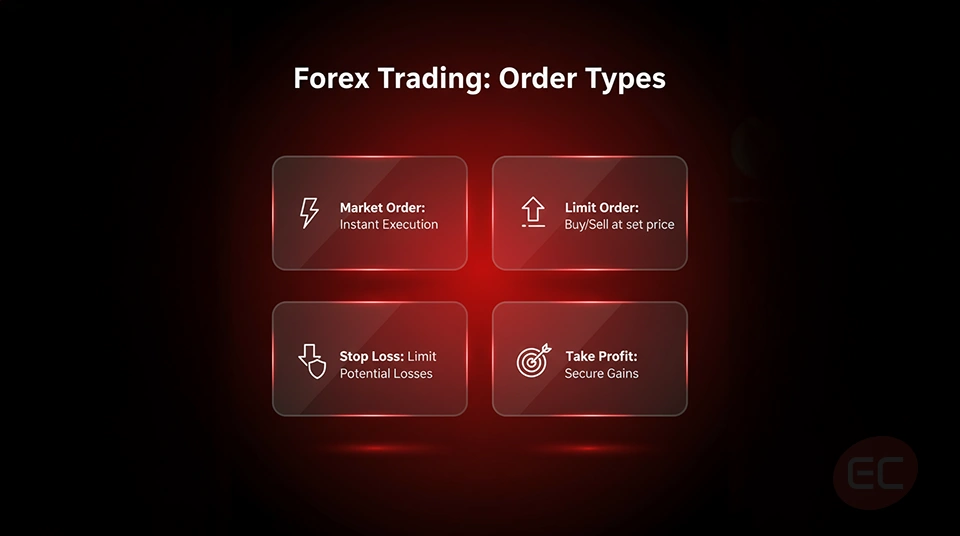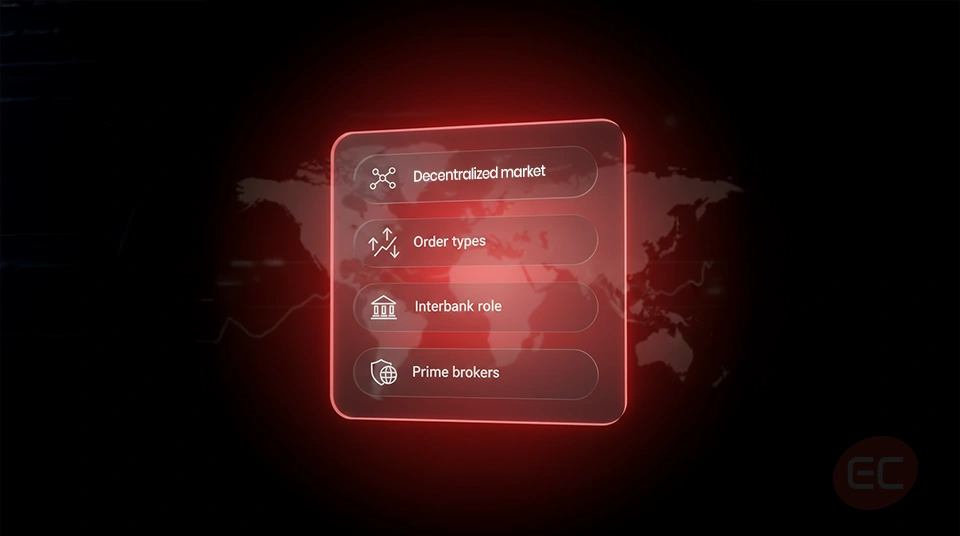Forex Market Structure: How it Works
The forex market, also known as the foreign exchange market, is the largest and most liquid market in the world, with over $6 trillion circulating per day in trading volume. But how is this enormous marketplace structured? In this article, we will look into the forex market structure, we’ll explain the crucial role of the interbank foreign exchange forex market and we will also break down what a forex order is, the different types of forex orders and how they interact within this key player ecosystem. Let’s get straight into it!
- What Is Forex Market Structure?
- Forex Market Structure: The Interbank Foreign Exchange Forex Market
- Understanding Forex Orders: Sell Orders Forex
- Sell Orders Forex and Forex Orders
- Forex Market Structure: How Prices Move
- Prime Brokers in the Forex Market Structure
- What Drives the Forex Market Structure?
- Why Forex Market Structure Matters
- Forex Market Structure Summed Up
- Forex Market Structure FAQ
- 1. What is the Forex Market Structure?
- 2. Why is the Interbank Foreign Exchange Forex Market important?
- 3. What’s the difference between a Limit Order and a Stop Loss Order?
- 4. How do Forex Orders flow through the market?
- 5. What are Sell Orders in Forex?
- 6. Who are the Key Players in the Forex Market Structure?
- 7. Why is the Forex Market decentralised?

What Is Forex Market Structure?
If you’ve heard the term ‘market structure’ in forex, it’s a term that refers to the organisational flow of trading activity between a variety of participants in the market. What does that mean? Well, look at the stock market as an example. The stock market typically operates through centralised exchanges like the NYSE. On the other hand, the forex market structure is decentralised, meaning that there is no single market location or exchange where all forex trading takes place.
So how does this enormous financial market stay so efficient? Let’s dive in:
The global market works in hierarchies. Right at the top, we have the interbank foreign exchange forex market where the biggest players like banks, central banks and larger financial institutions trade large volume currencies. From the second tier, liquidity descends down to smaller institutions, like brokers and retail traders. This multi-layered structure is how the forex market is able to operate 24 hours a day through different time zones, allowing for constant opportunities to buy and sell currencies.
Forex Market Structure: The Interbank Foreign Exchange Forex Market
The interbank foreign exchange forex market works as a type of backbone for the entire forex structure. It is in the interbank foreign exchange forex market where major banks and financial institutions operate large scale transactions, this works either on behalf of clients or for their own purposes. These sorts of transactions are generally measured in millions or even billions of dollars. The prices that are generated through the interbank market generally become a benchmark for the remaining layers of the forex structure, hence the term ‘backbone’. These prices influence the rates you see today on your own trading platform. So why is this important for you as a retail trader? Because the kind of million and billion dollar transactions that take place on the interbank foreign exchange forex market affects everything from spreads down to the execution speed of your own trades.
Understanding Forex Orders: Sell Orders Forex
Let’s look into the instructions used by traders to buy or sell in the market - forex orders. When placing sell orders forex traders usually rely on exiting a position or setting an automated condition to manage their risk. Understanding how sell orders forex works is crucial to making the right trading decision. So let’s begin:
Sell Orders Forex and Forex Orders

1. Market Orders
A market order is the more straightforward forex order. Why? Because it simply requires you to tell your broker to buy or sell a forex pair on the spot and at the best price available. Imagine it like walking into a shop and picking something up to buy it, it’s straight to the point. As simple as it sounds, it can also carry higher risk due to market volatility, so learning about market orders and how they work is crucial to your trading success.
2. Limit Orders
With limit orders, you have more control over the transaction. Limit orders are like saying ‘I would like to buy or sell, but only if the price hits a specific level’. Here’s an example: Let’s say EUR/USD is at 1.2150, if you believe that it will drop before it eventually rises again, you would want to place a buy limit order at around 1.2100. Who wouldn’t want to enter the market at a better price, right?
3. Stop Loss Orders
A stop loss order is one of the types of sell orders forex involves and it is often what’s referred to as your safety net. It’s triggered by the price movement against your position, essentially helping you limit potential losses. For example, assuming you bought EUR/USD at 1.2200 and you’re only willing to risk 50 pips, you would want to set your stop loss at 1.2150. It’s about trading smarter!
4. Take Profit Orders
On the other hand, a take profit order is another one of the types of sell orders forex involves and it is designed to secure your profits automatically. Let’s take the same example as the above: assuming EUR/USD will climb to 1.2300, you would place a take profit order at that point. Once the price hits that level, your trade would close and your profit would be locked in!
Forex Market Structure: How Prices Move
If you’ve made it this far, then you’ve covered the different types of buy and sell orders forex entails! But you might be wondering, how exactly do these forex orders influence and interact with the market?
Let’s break it down:
1) You’ve got retail traders, like you and I, who send orders through specific trading platforms.
2) Brokers. They receive orders and either match them or forward them to liquidity providers.
3) Liquidity providers. These include investment banks or hedge funds, they absorb these forex orders and provide the actual pricing and execution.
4) Interbank foreign exchange forex market. These forex orders may flow into the Interbank foreign exchange forex market, particularly if they are high volume forex orders.
So to break it down further, every single forex order you place is part of a much bigger system. Understanding how your trades fit into this system can get you a better understanding of slippage, spread changes and execution delays, all factors that are often unknown to beginner traders.
Prime Brokers in the Forex Market Structure
What are prime brokers and how do they play a role in the forex market structure? Prime brokers are the intermediary role, particularly for hedge funds, traders, and high volume clients. They provide access to the interbank foreign exchange forex market by providing access to clients to trade with multiple liquidity providers. Instead of dealing directly with a variety of different banks, large volume traders can access all through their prime broker. This setup allows for a simpler trading experience, it’s like having a VIP pass to every layer of the forex market. But not only that, prime brokers can also provide extremely valuable services to high volume traders, like reporting and risk management tools. To simplify it, prime brokers basically make it easier for high volume traders to access liquidity and manage their trading operations more seamlessly.
What Drives the Forex Market Structure?
The forex market structure is dynamic, it’s influenced by a number of factors, including economics, politics as well as technical factors like:
- Central Bank Policies: Interest rate changes can rapidly shift currency demand.
- Economic Indicators: Inflation rates, GDP growth rates and employment figures are amongst the data that can influence trading sentiment.
- Political Factors: Trade wars, elections and geopolitical conflict can create a shift in currency strength.
- Market Sentiment: Worldwide news and even trading psychology can have a major influence on how buyers and sellers enter the market.
Every one of these factors plays a significant role on how orders flow and how prices fluctuate.
Why Forex Market Structure Matters
Understanding the principles of the forex market structure isn’t just about the theory, it’s about understanding the real world implications of how you place a trade. It involves:
1) Better risk management: knowing when to place a stop loss or when to place a limit order can make the difference between a successful trade and a loss.
2) Smarter time management: understanding when the interbank market is the most active can help you make better trading decisions during times of higher liquidity.
3) Improved strategies: when you understand how buy and sell orders forex trading involves are processed, you can create a tailored strategy that fits the current market conditions.
All in all, understanding the forex market structure is crucial to getting an edge in a competitive market!
Forex Market Structure Summed Up
It might seem daunting to navigate the forex market structure at first glance, but once you understand how each layer is interconnected, from the interbank foreign exchange forex market down to your own trading platform, it becomes a whole lot easier to make informed, strategic trading decisions that can make the difference between a significant profit, and a loss. Remember, the financial market isn’t moving at random, there’s an underlying logic to how the buy and sell orders forex traders place are processed and how market prices move on a daily basis.
Forex Market Structure FAQ

1. What is the Forex Market Structure?
It’s how the global currency market is organized, from large banks in the interbank market down to the individual retail trader.
2. Why is the Interbank Foreign Exchange Forex Market important?
It’s a crucial factor in understanding how higher or lower liquidity levels can influence your trades, even if you’re using a retail broker.
3. What’s the difference between a Limit Order and a Stop Loss Order?
A limit order sets the specific price you choose to enter or exit a trade to make a profit. On the other hand, a stop loss order limits you potential losses by closing the trade if the market starts moving against you.
4. How do Forex Orders flow through the market?
Forex orders flow from the retail traders down to the brokers, once with the brokers, they may pass them on to liquidity providers or to the interbank market. This structure is designed to ensure that buy or sell orders forex traders make reaches the relevant counterparty, ensuring the maintenance of liquidity and price stability in the market.
5. What are Sell Orders in Forex?
Any sell orders forex traders place are instructions to sell a specific currency pair at a specific price or market value. It’s a key and vital part of the forex order flow. It ensures that traders capitalise on downward price trends in the financial market.
6. Who are the Key Players in the Forex Market Structure?
The key players include: central banks, commercial banks, hedge funds, brokers and retail traders, like you and I. The forex market structure works as a hierarchy, with the interbank foreign exchange forex market ranking at the very top as a key player, followed by the institutional and retail layers.
7. Why is the Forex Market decentralised?
In comparison to the Stock Market, there is no direct central exchange in the forex industry. Forex works by over the counter transitions through a wide range of banks and brokers, making the forex market structure decentralised by nature.
Congratulations for making it this far into our course! Whether you’re managing your risk strategy with stop losses, or optimising your entry points by using limit orders, this knowledge puts you in control of your own trading journey! But this is just the beginning! If you found this article useful and you would like to deepen your trading knowledge, then keep on reading the EC Academy as we explore more topics that will take you from a beginner to an expert trader in no time!